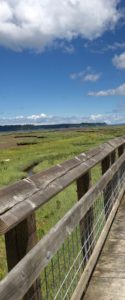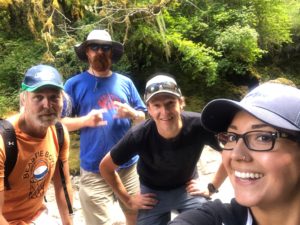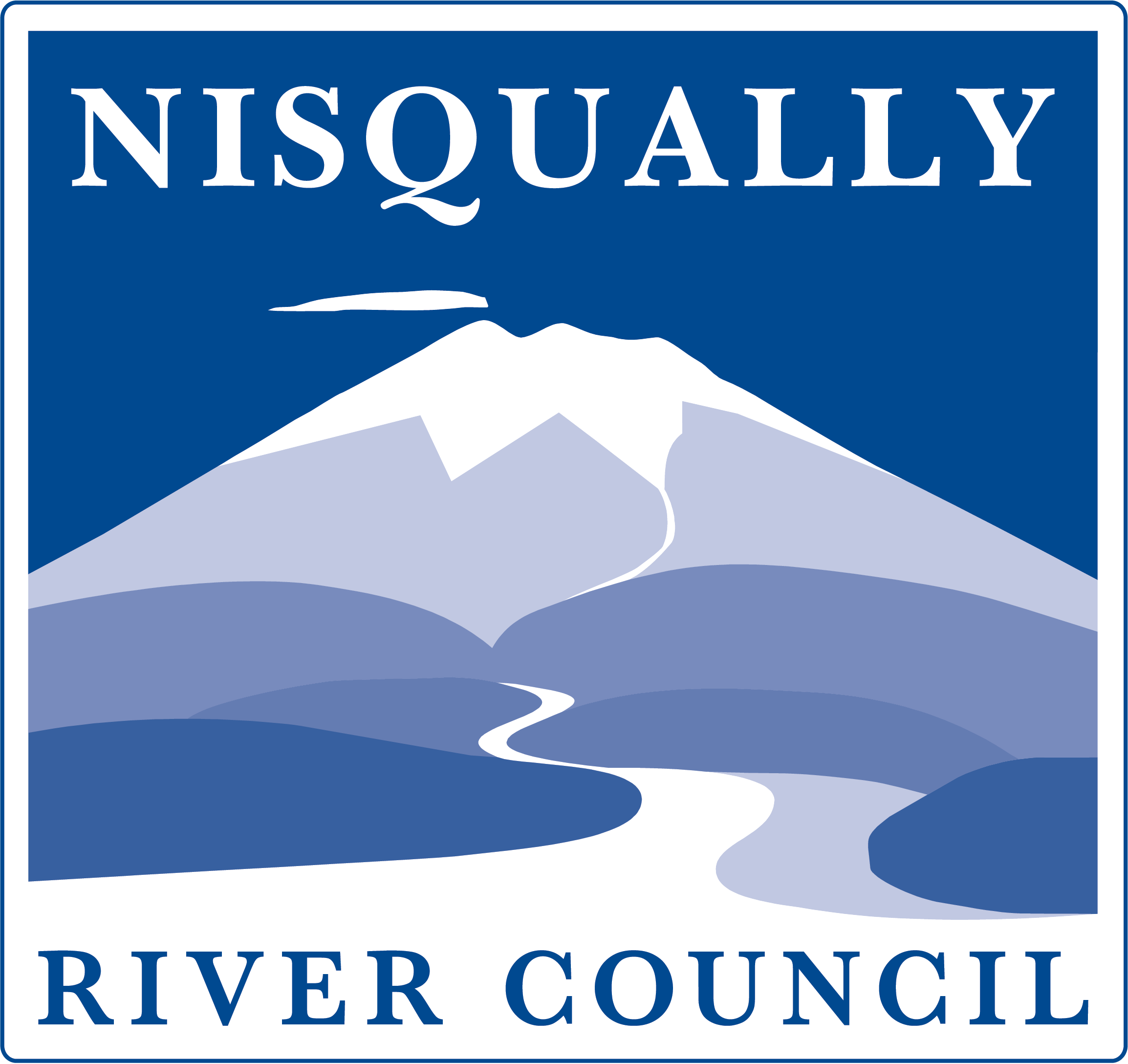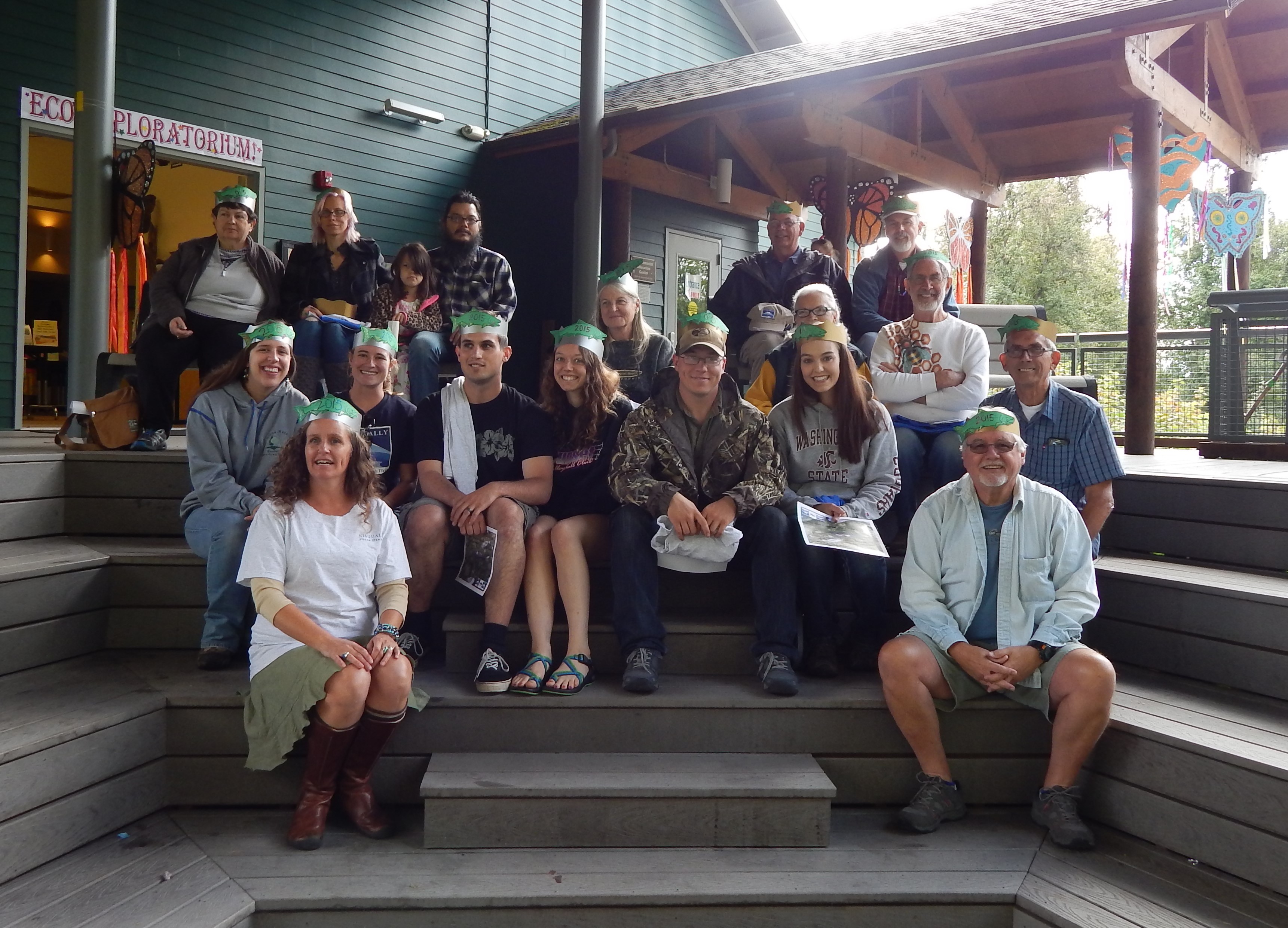Read all about the Summer Institute for Teachers 2018 by our summer intern from Evergreen State College Amber Left-Hand-Bull.
On June 25-27, 2018, the Nisqually River Education Project and its partners South Sound GREEN and Chehalis Basin Education Consortium presented the Summer Institute for Teachers 2018: Climate Change in the Pacific NW: Urban Environments, Flooding and Sea Level Rise at the Billy Frank Jr. Nisqually National Wildlife Refuge. Over the course of 3 days, over 40 teachers participated in learning regional climate change science from a variety of educators who specialize and work in this field. The Institute is to help educators gain more knowledge on climate change science to provide new and updated studies for students. The teachers experienced hands on activities and field investigations while receiving curriculum resources to help support their service learning projects. They gained skills and experiences that will help implement climate change curriculum and action projects for community resiliency in their classrooms.
Day 1: Sea Level Rise and Flooding
June 25th was the first day of the Institute that focused on sea level rise (SLR) and flooding with various workshops and guest speakers. Starting with Davy Clark, the Environmental Education Coordinator at the Billy Frank Jr. Nisqually National Wildlife Refuge, teachers learned about the history of the Nisqually Estuary and the beginning of the Refuge it became in 1974. This was a good foundation in where teachers were, and what this delta meant for many people and programs. His presentation included the environmental impact and change ,from the farm development to the restoration. Davy also included the Nisqually Indian Tribe’s cultural impact around this federal lands, which was later dedicated to the Nisqually Indian Tribe’s respected and honored elder leader Billy Frank Jr., known for his efforts in fighting for the Tribes’ fishing rights.

The day continued with more experts on sea level rise and how that affects Washington, now and in the future. Nicole Faghin, a Coastal Management Specialist with Washington Sea Grant, went over of the science of sea level rise, from the planet heating up with climate change with greenhouse gases and solar radiation to melting glaciers and how scientists make these projections. The breakdown in what these all mean and how to understand it was a great base for the teachers to frame work studies for their students.
Many of the presenters that followed Nicole had preventive and solution initiatives to accommodate these challenges and changes with the kind of conditions. Presenters included followed:
- Eric Christensen, Stormwater Engineer, City of Olympia
- Brenda Snyder, Landscape Architect / Urban Designer, Barghausen Consulting Engineers
- Rhys Roth, Director, Center for Sustainable Infrastructure
- Chris Ellings, Biologist Manager, Salmon Recovery Program, Nisqually Indian Tribe Department of Natural Resources
The last hour of the day took part in breakout sessions in four rotations of 25 minutes each where teachers participated in games and labs of the things that were discussed over the day. This was to review and put in focus how students can expand the logic and understanding of what sea level rise and climate change is.
The breakout sessions:
- Nisqually Estuary Restoration Puzzle – Lucia Harrison, visual artist and Faculty Emeriti at The Evergreen State College
- NOAA Thermal Expansion Lab – Stephanie Bishop, South Sound GREEN
- “Game of Floods” – Sheila Wilson, NREP & Brandon Bywater, AmeriCorps
- Hands on Watershed Modeling to Understand Stormwater Pollution – Darcy Bird, City of Lacey AmeriCorps Volunteer
- NOAA Beat the Uncertainty Game (Upper Elementary – Middle School) – https://games.noaa.gov/beat-the-uncertainty/welcome.html
Day 2: Field Trips- Tour of the Deschutes Watershed
June 26th, the second day of the Institute, was a field trip day of the Deschutes Watershed starting from the headwaters to the mouth (beginning and end). Guest speaker Wendy Gerstel, of QWG Applied Geology, gave a basic geological review of the Puget Sound and Deschutes Watershed. The rest of the day consisted of the watershed tour of the Deschutes with various activities to enlighten how teachers can include these sciences into their curriculum.
The ride to the first stop was a little over a hour in which the teachers were given a handout called Project WET outlining and defining a watershed. The destination at the Deschutes Falls was conducted in field investigations of water quality testing and stream surveys. The faculty will have water quality testing opportunities for their class and this is a component of what they will be performing.

With some minor traffic and construction the next destination was a quick review in stormwater projects. The Yelm Highway Stormwater Facility at William A. Bush Park in Lacey showed the kind of stormwater engineering that is better for our streams and rivers. Stephanie Bishop, South Sound G.R.E.E.N. Coordinator in Thurston Conservation District, gave a Wetland Metaphors project that can show students how to think differently when dealing with new ideas and taking new angles on projects like stormwater engineering.
Next stop was at the Tumwater Falls Park, where guest presenter Sue Patnude, Executive Director of the Deschutes Estuary Restoration Team (DERT), gave the class a tribal background in what this watershed means to the Squaxin Island Tribe and how they are working to help restore the Deschutes Estuary.
The class then met at the mouth of the Deschutes Watershed in downtown Olympia at the Capital Lake. The teachers listened to Eric Christensen & Susan Clark with City of Olympia on the downtown portion of sea level rise and how future planning is already in the works. The city has taken SLR into consideration and how buildings are already being affected by these conditions. Some of the planning and ideas consisted of removing buildings and structures in high risk areas to raising buildings above the current sea level.
The last stop of the tour ended with an optional kayak tour from Swantown Marina to Priest Point Park with Sam Kaviar, Kayak Nisqually and Mike Baker, Olympia Parks and Rec. The kayak tour was a perfect ending to the day with calm waters and clear skies. It gave the importance of what had been covered so far with environmental impacts and efforts of change.

Day 3: Curriculum Resources, Action Projects, and Planning Time
June 27th, the last day, included a few more presentations and project resources on how to use the all the different objectives covered. One goal of the Institute is to show how the science involved can include students with all ranges of talents and interest areas. Starting with Stephanie Bishop, Matt Samson, and Aerial Wahoub in “Tideline Project: Art as Action”, teachers looked at an art project done by volunteers at the Procession of the Species where they demonstrated the impacts of sea level rise in Olympia last April, 2018. (Read more here: https://www.theolympian.com/entertainment/article208628649.html).
After that was “Data in the Classroom” with Maggie Allen, an Education Specialist with the National Oceanic and Atmospheric Administration (NOAA). This compiled computer science with storyboards and actual online testing/review with what the students have learned. This program can be grade manipulated and is kid friendly.
In a litter assessment project, the teachers learned about waste impacts worldwide and state based, with presenters Heather Trim, Zero Waste Washington and Christine Rayburn, Stop Sucking! The Strawless Olympia Campaign. The presentations emphasized current waste issues and statistics that contribute to harm our water today. Ending on a positive note the teachers learned of various solutions and strategic practices that can help eliminate these issues.
The last but not least presenter, Elizabeth Campbell with the Squaxin Garden in Tribal Curriculum Resources went over the tribes “Traditional Food Box”. The box held wild food and medicine native to Washington that has been practice with the tribe thousands of years. To see more of this follow this link from Elise Crohn’s website: www.wildfoodsandmedicines.com
For more Native American knowledge and the Nisqually Indian Tribe’s effort and history of protecting the waters of Nisqually Watershed, the following links were shown and made available for the teachers and their classrooms:
- Billy Frank Jr. Salmon Defense Video
- Native Knowledge 360
In two 45 minute sessions the class broke up into small groups in rotation of action projects to practice and learn more of the list below:
- Fecal Coliform Testing and Water Quality – Stephanie Bishop, South Sound GREEN
- Benthic Macroinvertebrates – Davy Clark, Billy Frank Jr. Nisqually National Wildlife Refuge
- Do One Thing Videos – Sheila Wilson, Nisqually River Education Project
- Oyster Dissection and Micro-plastic Monitoring – Aeriel Wahoub, South Sound GREEN AmeriCorps
Last year’s Summer Institute for Teachers had returned faculty who shared some of their projects over the year and how it impacted their students and community with climate resiliency. The last 30 minutes was meeting their watershed program or program assessment to review the requirements and calendar for the 2018-19 school year. At the end of the day all educators and outreach programs left with more knowledge and tools to help serve their communities and classrooms for a better tomorrow.
Read more about the Nisqually River Education Project and follow NREP on Facebook for updates throughout the year!



